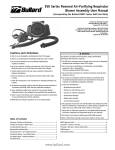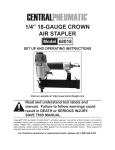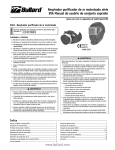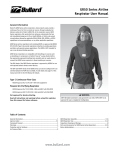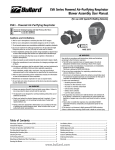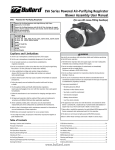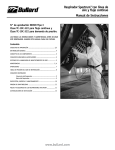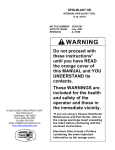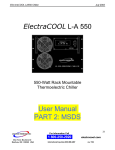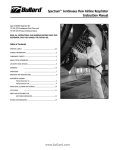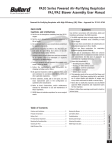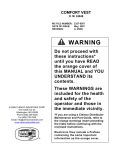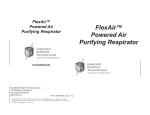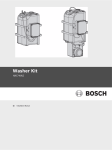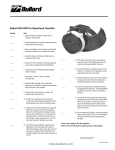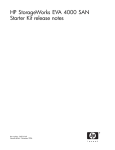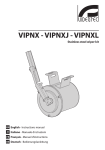Download EVA Series Powered Air-Purifying Respirator Blower
Transcript
EVA Series Powered Air-Purifying Respirator Blower Assembly User Manual (Incorporating the Bullard Spectrum® Series Full Face Mask) Powered Air-Purifying Respirator with High Efficiency (HE) Filters Approval No. TC-21C-0844 Powered Air-Purifying Respirator with OV-AG-HE Filter Cartridges for organic vapors, chlorine, hydrogen chloride, sulfur dioxide, chlorine dioxide, hydrogen fluoride and particulates – Approval No. TC-23C-2512 � WARNING Use strictly in accordance with instructions, labels and limitations pertaining to the EVA Series respirator. Cautions and Limitations A. Not for use in atmospheres containing less than 19.5% oxygen. B. Not for use in atmospheres immediately dangerous to life or health. 1. The EVA Series respirator does not supply oxygen. Use only in adequately ventilated areas containing at least 19.5% oxygen. C. Do not exceed maximum use concentrations established by regulatory standards. 2. Do not use when concentrations of contaminants are immediately dangerous to life or health (IDLH). This term is defined in 29CFR 1910.134 (b). F. D o not use respirator if airflow is less than four cfm (115 lpm) for tight fitting face pieces or six cfm (170 lpm) for hoods and/or helmets. 3. Do not use these respirators for respiratory protection during abrasive blasting or clean up. H. Follow established cartridge and canister change schedules or observe ESLI to ensure that cartridges and canisters are replaced before breakthrough. 4. Do not use in circumstances where the airborne concentration level of contaminant exceeds maximum use concentration for this type of respirator as established by regulatory standards. I. Contains electrical parts that may cause an ignition in flammable or explosive atmospheres. 5. Leave area immediately if: J. F ailure to properly use and maintain this product could result in injury or death. • Dizziness or other distress occurs K. The Occupational Safety and Health Administration regulations require gas-proof goggles to be worn with this respirator when used against formaldehyde. L. Follow the manufacturer’s user instructions for changing cartridges and/ or filters. M. All approved respirators shall be selected, fitted, used and maintained in accordance with MSHA, OSHA and other applicable regulations. N. Never substitute, modify, add or omit parts. Use only exact Bullard replacement parts in the configuration as specified by the manufacturer. O. R efer to User’s Instructions and/or maintenance manuals for information on use and maintenance of these respirators. P. NIOSH does not evaluate respirators for use as surgical masks. • Breathing becomes difficult • You taste or smell the contaminant • Unit becomes damaged • Battery alarm activates • Low Flow alarm activates 6. This apparatus must not be worn with the blower unit switched off. If the blower is switched off, a rapid build-up of carbon dioxide and depletion of oxygen may occur, which could result in death or serious injury. 7. Never alter or modify this respirator. Use only Bullard NIOSHapproved EVA Series components and replacement parts for this respirator. 8. This device is not immune to highly powered RFI/EMI emissions. Failure to follow these warnings could result in death or serious injury. Table of Contents Warnings, Cautions and Limitations................................................................ 1 Principle of Operation ..................................................................................... 2 Battery Pack...................................................................................................... 2 Pre-Operational Inspection.............................................................................. 3 Mounting the Breathing Tube............................................................................ 3 Checking Air Flow............................................................................................. 4 Air-Purifying Elements..................................................................................... 4 Mounting and Replacing Cartridges................................................................. 4 Donning the Blower......................................................................................... 5 Doffing the Blower / Low Battery Alarm......................................................... 6 Troubleshooting................................................................................................ 7 NIOSH Approval Label..................................................................................... 8 Inspection and Cleaning................................................................................... 9 Fit Testing / Warranty / Return Authorization............................................... 10 Diagram........................................................................................................... 11 Order Information........................................................................................... 12 www.bullard.com EVA Series - Principle of Operation The EVA Series Powered Air-Purifying Respirator (PAPR) System is configured in six parts: 1. The blower and belt assembly: EVA1 Blower Unit EVABELT1 Comfort/Decon Belt PA4AFI Air Flow Indicator (sold separately) 2. The battery pack (Part No. EVABAT2). One fully charged pack will power the blower for approximately four to six hours depending upon factors such as speed, cartridge selected and cartridge loading. Type C Airline Respirators NOTE Battery Pack The EVABAT2 is green and is not for use with Loose Fitting Hoods or Loose Principle of Operation / Battery Pack Fitting Face Pieces. 2 3. The PA4BT Mask breathing tube assembly (standard length) 4. The High Efficiency Particulate Absolute (HEPA) filter or Organic Vapor, Acid Gas, HEPA Filter Cartridge. 5. The Full Face Mask: The following models may be used with the EVA Series blower unit: PASPECML (Medium/Large) PASPECS (Small) 6. The Battery Charger: EVASMC Quick charger EVAGC Gang charger The blower unit draws in ambient air through the cartridge. The purified air is blown into the wearer’s mask through the breathing tube. A flow indicator is provided to check that there is an adequate volume of air available to the wearer prior to use. The system is designed to operate at a minimum air flow of approximately 4.5 cubic feet of air per minute (128 liters per minute) in the mask under normal use on the standard speed setting, and 5 cubic feet of air per minute (142 liters per minute) in the mask under normal use on the high speed setting. A feedback loop from the Mass Flow Sensor to the impellor continually monitors and adjusts the air flow to keep it constant at the design set point. The units are designed for use at temperatures from 10ºF to 120ºF (-12ºC to 49ºC). The battery pack mounts in a compartment on the back of the blower. A fully charged battery pack will power the blower for approximately four to six hours depending upon factors such as speed selected, cartridge selected, and filter/ cartridge loading. The EVA Series Blower is equipped with two alarms: A 77 db continuous alarm will sound when the air flow reaches approximately 115 lpm and a 77db intermittent chirp alarm will activate to indicate that the battery has approximately 15 minutes of remaining capacity. Spectrum Series (TC-19C-322), Continuous Flow (TC19C-321), Pressure Demand (TC-13F-387, TC 13F388), Combination SCBA & Type C Pressure Demand (TC-19C-354) The Spectrum Full Face Mask used with the EVA PAPR can also be configured for use in Supplied Air Configurations. Refer to the Spectrum Series Supplied Air Respirator User Instructions for details. One fully charged battery pack will power the blower for approximately four to six hours depending upon factors such as speed selected, cartridge selected and filer/cartridge loading. NOTE The battery has built-in short circuit protection. In the event of a short circuit, an internal polyfuse will trip. The fuse will reset itself within 5-10 seconds allowing the battery to resume normal operation. To charge the battery pack, do the following: • Press the battery release on the pack to remove the battery from the back of the blower. (See Figure 1.) Battery release Figure 1 Figure 2 • Place battery upside down into the charging port of the battery charger. (See Figure 2.) • Connect the battery charger to a 110-volt AC electrical outlet. • Charge the battery pack for approximately four hours. While the battery is charging, the light on the charger will remain red. The charger light will illuminate green when charging is complete. Table-top gang chargers EVAGC with 6 ports are also available. Diagnostic functions are available for chargers (upon special order) including access to data such as number of cycles of operation, remaining charge capacity, etc. Details for these functions are available in the charger user manual (upon special order). www.bullard.com EVA Series Powered Air-Purifying Respirator Blower Assembly User Manual (Incorporating the Bullard Spectrum® Series Full Face Mask) 1. Belt Mounted Blower Unit, Part No. EVA1 • Check that the unit is clean and undamaged. � WARNING DO NOT charge batteries in hazardous areas. • Inspect for deterioration, physical damage and improper assembly. Battery Storage Storage of Li Polymer batteries is relatively easy. Unlike Nickel batteries, they lose a very small amount of power (less than 0.5% per day) and therefore can be charged and stored ready for use. If long-term storage is required, it is best to store the battery in a cool place with at least 40% charge still remaining. NOTE 2. Filter/Cartridges • Inspect the filter/cartridge for any physical damage • Check the label to ensure the filter/cartridge has not exceeded its “use-by” date. • Inspect the gasket on the filter for any physical damage. NOTE 25ºC 96% after 1 year 80% after 1 year Each filter comes with a permanent gasket. • Ensure that the correct filter/cartridge is appropriate for the contaminant. • Consult the NIOSH approval label and your own in-plant safety professional if you have any questions as to the suitability and efficiency of the Air-Purifying Element. • Screw the cartridge into the port until handtight and the locking tab is secure. (Refer to Mounting and Replacing Filters on Blower Unit on page 5) 40ºC 85% after 1 year 65% after 1 year 3. Battery Pack 60ºC 75% after 1 year 60% after 3 months Discharging and re-charging the battery fully at least once every 3 months is suggested to ensure the longest possible life of the battery. Temperature 40% charge level (recommended storage charge level) 100% charge level (typical user charge level) 0ºC 98% after 1 year 94% after 1 year To maximize battery life, these guidelines should be followed: • Remove the battery from the blower unit when not in use. • Charge the battery before it is completely discharged. The low battery alarm indicates that the battery needs to be charged. The battery is designed with a circuit to protect the battery. It will not allow the battery to be discharged below a safe voltage for the cells, regardless of airflow, without the alarm sounding. When the battery reaches the voltage cutoff it will automatically cease operation. • Always charge the batteries at room temperature or cooler. At higher temperatures, the battery pack may not accept a full charge. If the battery pack feels hot, let it cool for 30 minutes before charging. • Battery capacity may be checked with a diagnostic charger (special order). • Table-top gang chargers (Part No. EVAGC with 6 ports) are also available. The EVABAT2 is green and is not for use with Loose Fitting Hoods or Loose Fitting Figure 4 Face Pieces. • Check that the battery is not damaged. • Check the Fuel Gauge to determine sufficient charge is available. • Place the battery pack in the battery compartment on the blower. • The battery tab should click when completely engaged. (See Figure 4) 4. Full Facepiece and Breathing Tube • Inspect the full facepiece for any physical damage, such as torn head harness straps, scratched or cracked visor and distortion of the rubber flange. • Inspect the breathing tube for tears, cracks, holes or excessive wear that might reduce the degree of protection originally provided. • Ensure that the rubber seal is present in the mask inlet. • Replace any damaged parts with the proper Bullard replacement part to maintain the NIOSH approval. Mounting the Breathing Tube on the Blower • Ensure that a rubber gasket is in place in the breathing tube coupler on the Battery Fuel Gauge: EVA Battery Packs are equipped with an on-board fuel gauge to indicate the amount of remaining capacity left in the battery pack. To check the remaining capacity, simply depress the button Figure 3 labeled “Push” and LEDs will illuminate indicating the level of battery capacity remaining. When fully charged all four LEDs will illuminate green, and when 25% or less charge is available a single LED will illuminate red. Pre-Operational Inspection Prior to each work shift, perform the following Pre-Operational Inspection to ensure proper operation and to ensure that the unit is completely assembled. blower unit. • Screw one end of the breathing tube into the blower unit. (Hand tight is sufficient.) (See Figure 5). • Ensure that neither the breathing tube nor the filter is blocked. • Ensure that the ON/OFF Switch is in the OFF position. • Switch on the blower by pressing the on/off button for 1-2 seconds confirmed by a short beep. • If the Low Battery Alarm sounds at this time, the battery needs to be recharged. See instructions on page 2 regarding properly Figure 5 charging the battery. • If the Low Flow Alarm sounds at this time, the mask, breathing tube and filter should be check for a blockage. www.bullard.com Battery Pack / Pre-Operational Inspection • Do not charge battery packs in an enclosed cabinet without ventilation. NOTE 3 Checking Airflow with the Airflow Indicator (PA4AFI - sold separately) Mounting and Replacing Filters on the Blower Unit With the blower switched ON and the filters/ cartridges mounted, take the free end of the breathing tube in one hand, hold it upright and place the Airflow Indicator into the end of the tube. (See Figure 6). Apply a light downward pressure to the Airflow Indicator to get a reasonable seal at the breathing tube end. Ensure that the air outlet holes in the Airflow Indicator tube are not blocked. Two hands may be used if preferred, one to hold the breathing tube and one to hold the Airflow Indicator. Figure 6 The position of the ball in the Airflow Indicator should be observed. If any part of the ball is below the PASS LINE on the Airflow Indicator, check for: • Blower malfunction. • Clogged or damaged Air-Purifying filter elements on the HE filter. See “Mounting and Replacing Cartridges on the Blower Unit” on page 7. • Low battery or battery malfunction. If the ball is completely above the PASS LINE on the Airflow Indicator, then the system is ready for use. High efficiency particulate filters must be replaced when retained particles clog the filters and reduce air flow below acceptable levels, as indicated by testing with the Air Flow Indicator as described at left. � WARNING To Replace Combination Filter/Cartridge • Follow the steps above, but beware that the filter locking tab is beneath the filter rim. (see Figure 10) If the blower malfunctions during use in a hazardous area: Remain calm and LEAVE the hazardous area immediately. DO NOT use a blower that fails the flow test (air flow indicator sold separately). Use ONLY Bullard filter/cartridges which comply with and have the NIOSH approval label and which are appropriate for the contaminant. Failure to observe these warnings could result in death or serious injury. Figure 8 EVA Series PAPR Air-Purifying Elements Checking Airflow / Air-Purifying Elements Principle of Operation 4 The following filter/cartridge protection classification applies when used with any of the hoods or loose fitting facepieces. Protection HE OV/CL/HC/ SD/CD/HF/HE Filter/Cartridge Type NIOSH / ANSI Color Code for Cartridge Label PAPRFC3 Magenta PAPRFC4 Olive and Magenta HE particulate filters are 99.97% effective against all particulate aerosols. Filters are supplied in quantities of three per box. The following abbreviations are approved by NIOSH to indicate the particulates, gases, or vapors which are removed by the gas/vapor cartridges: HE High Efficiency Particulate Air Filter for Powered Air-Purifying Respirators � WARNING Use only the filter/cartridge(s) described in the above table. Do not change cartridges while in a hazardous atmosphere. Incorrect cartridge selection will invalidate all performance statements and approvals for this equipment. Follow established cartridge change schedules to ensure that cartridges are replaced before breakthrough occurs. Failure to follow these warnings could result in death or serious injury. Figure 7 To Replace Filters • Remove the air-purifying element from its packaging, and inspect for damage. If in doubt do not use. • Check that the air-purifying element has not exceeded its “use-by” date. • Check that the filter connecting thread and gasket are in good condition. • Check that the air-purifying element is appropriate to the hazard. If in doubt consult your respirator program administrator or supervisor. • Check that the threads in the blower unit port are in good condition and clear of contaminant. • Screw the air-purifying elements into the receptacles (see Figure 8) until the cartridge is hand tight. DO NOT OVERTIGHTEN. • Check to see that the locking tab is secure. (see Figure 9) Locking tab Locking tab Figure 9 Figure 10 Installing and Removing the Belt on the Blower Unit To install the belt • With the blower filter side down, orient the lever locks as shown in Figure 11 • Lay belt over blower as shown in Figure 12 • Rotate level locks until they are oriented as shown in Figure 13 Figure 11 Figure 12 Figure 13 To Remove the Belt • With the blower filter side down, orient the lever locks as shown in Figure 12 • Remove belt from blower www.bullard.com EVA Series Powered Air-Purifying Respirator Blower Assembly User Manual (Incorporating the Bullard Spectrum® Series Full Face Mask) NOTE Plastic insert may be removed for cleaning as shown in Figure 13-14 . See back page for more information on cleaning. Donning the Spectrum Full Facepiece Release the headstraps to the full outward position by pulling the headstrap quick release tabs forward. When fully extended, tabs should be located at the headstrap latches. Grasp the headstrap harness with thumbs through the straps. Spread outward. Figure 13 Figure 14 Donning the Blower and Respirator Initial Donning Prepare to don the blower, battery and facepiece in a safe, hazard-free area and do the following: • Ensure that the cartridge used is suitable for the contaminant in question and is compatible with the EVA Blower Unit. Figure 17 � WARNING The use of any filter/cartridge not approved with the EVA blower units may put the user at risk and could result in death or serious injury. • Check that the cartridge is properly mounted on the blower unit. • Prior to assembling the system, place the battery in the battery compartment on the back of the blower. Fit the blower and belt around the user’s waist. With the blower at the rear of the user, adjust the belt for a comfortable fit. • Remove the belt and blower. • Ensure that the rubber seal is present in the mask inlet. Screw the breathing tube elbow into the mask inlet until tight. (See Figure 15) Figure 16 Push the top of the facepiece flange up the forehead, brushing hair upward from the face seal area (see Figure 16). Continue up and over the head until the harness is centered at the rear of the head, and the chin rests in the chin cup. Pull both lower straps at the same time towards the rear (see Figure 17). Tighten the two temple straps. Tighten the top head strap if necessary. Adjust headstraps until the facepiece fits securely and evenly. Perform a negative pressure fit check: A. W ith facepiece on and secured, place your hand over the end of the breathing tube (see Figure 18). Figure 18 B. I nhale until the mask collapses inward lightly (indicating there is negative pressure). Hold your breath for five seconds. C. The mask is deemed to be in proper position if it remained collapsed while the breath was held, and no inward leakage of outside air was detected. � WARNING If you cannot obtain a proper fit, try another mask size and repeat the same steps outlined above. If a proper fit is still not achieved, do not use this respirator. Failure to follow these instructions could result in death or serious injury. Turn on the blower, and attach the breathing tube to the blower. With the air flowing into your respirator, you are now ready to enter the work area. � WARNING Figure 15 � WARNING Do not wear the EVA full facepiece PAPR with prescription glasses because the temple pieces will interfere with the facepiece seal. Use only the SPECPL Spectacle Frame Assembly to mount prescription oculars. Do not wear the EVA full facepiece PAPR if facial hair is present that comes between the sealing surface of the facepiece and the face, or that interferes with valve function. Failure to follow these instructions could result in death or serious injury. The mask over must be used when operating this respirator. This part protects the exhalation valve from outside interference. Failure to follow these instructions could result in death or serious injury. www.bullard.com Donning the Blower / Low Battery Alarm D. If the mask doesn’t collapse or if an inward leak is detected, re-adjust mask on face and repeat above steps until the test is passed. 5 Final Donning: • Attach the other end of breathing tube to blower unit (if not already attached) by screwing adapters together. • Remove any protective film covering the lens of the mask. • Put on the belt and blower assembly and make any final adjustments to the belt as necessary. on/off switch • Turn the blower on by depressing and holding the on/off switch (Figure 19) for approximately 1 second indicated by a short beep. • Buckle the belt onto the waist (blower unit should be in the lower back of Figure 19 the wearer). • Choose speed setting (see below). • Place the mask on the head making any final adjustments to the fit as required at this time to ensure a comfortable and stable fit. Donning the Blower / Low Battery Alarm/Doffing the Respirator � WARNING 6 Do not enter a hazardous area until you are sure that the blower and mask are fully operational and the blower is running. The user should periodically leave the hazardous area to check the airflow through the system. If the low battery or low flow alarm should sound, or if the user experiences any difficulty in breathing, or senses any taste or any odors from the hazard, the user should leave the hazardous area immediately. Failure to observe these warnings could result in death or serious injury. Speed Selection The EVA1 Blower is equipped with the ability for the user to select one of two speeds for operation. When the unit is initially turned on and green EVABAT2 is installed, the blower will operate at approximately 5.0 cfm=142 lpm. NOTE The battery life is reduced at the higher speed. Pressing the on/off switch will change the speed to approximately 4.5 cfm = 128 lpm (low speed). Low Battery Alarm and Low Flow Alarm (continued) When either of these alarms sounds, the user should immediately do the following: Leave the hazard area Remove the headpiece Disconnect the breathing tube from the mask Check the airflow with the airflow indicator (see page 4). If the airflow indicator indicates insufficient airflow, the battery should be fully charged (see “Battery Pack” on page 2), and/or the filter/cartridge should be replaced. NOTE The EVA1 blower is provided with a circuit to protect the battery. It will not allow the battery to be discharged below a safe voltage for the cells, regardless of airflow, without the Alarm sounding. When the battery reaches the voltage cutoff it will automatically cease operation. When the Low Battery Alarm sounds and the filter cartridge is not clogged, the battery should be recharged to protect the battery and thereby prolong the working life of the unit. If the ball in the Airflow Indicator is BELOW or PARTLY BELOW the PASS LINE with a fully charged battery, the filter cartridge may need to be changed. Doffing the Respirator Prepare to doff the blower, battery and mask in a safe, hazard-free area and do the following (in conjunction with your employer’s standard operating procedures): • Remove the mask by lifting the tabs on the latches. • Turn the blower off by holding down the on/off switch for 5 seconds. This is confirmed by a long beep and a shut down of the motor. • Remove the waist belt. • Disconnect the mask from the breathing tube. • Disconnect the breathing tube from the blower. • Clean and inspect components as necessary. • Place battery on charger (as desired). • Place components in storage. Pressing the on/off switch additional times will toggle the unit between the two speeds. NOTE Speed change is confirmed by a short beep. Low Battery Alarm and Low Flow Alarm � WARNING The use of any filter/cartridge not approved with the EVA1 blower unit may put the user at risk and could result in death or serious injury. The EVA1 Blower unit is equipped with a Low Battery Alarm and a Low Flow Alarm. The Low Battery Alarm will sound an intermittent 77 dba electronic beep indicating that there are approximately 15 minutes of remaining battery capacity. The delays between beeps will get shorter and shorter as time runs out. The Low Flow Alarm will sound a continuous 77 dba electronic beep indicating that the flow to the mask has dropped below the design specification of 115 lpm = 4.0 CFM (Note: The NIOSH minimum required flow is 115 lpm=4 CFM). www.bullard.com EVA Series Powered Air-Purifying Respirator Blower Assembly User Manual (Incorporating the Bullard Spectrum® Series Full Face Mask) Troubleshooting The following guide will assist you in troubleshooting to locate possible issues with your respirator: Circumstance Possible Cause(s) Solution Low Battery Alarm is sounding Low Voltage Blower malfunction Charge the battery Return blower for analysis Low Flow Alarm is sounding Clogged/damaged air-purifying filter element Battery Low Blower malfunction Replace the filter/cartridge. Re-charge the battery. Leave hazardous area immediately and check equipment. If the problem persists and no damage is found, return equipment for repair. Replace breathing tube and/or mask. Smell or taste contaminant Equipment damaged. Leave hazardous area immediately and check equipment. Replace filter. Leave hazardous area immediately and check equipment. If the problem persists and no damage is found, return equipment for repair Filter needs to be replaced Low airflow. Blower unit does not run full service life Damaged Battery Malfunctioning Battery Charger Return battery for analysis Return charger for analysis Troubleshooting www.bullard.com 7 X HE OV/CD/CL/ HC/HF/SD/HE 21C-0844 23C-2512 PASPECML X X X X X X X X EVABELT1 X A. Not for use in atmospheres containing less than 19.5% oxygen. B. Not for use in atmospheres immediately dangerous to life or health. C. Do not exceed maximum use concentrations established by regulatory standards. F. D o not use this respirator if airflow is less than four cfm (115 lpm) for tight-fitting facepieces or six cfm (170 lpm) for hoods and/or helmets. H. Follow established cartridge and canister change schedules or observe ESLI to ensure that cartridges and canisters are replaced before breakthrough occurs. I. Contains electrical parts which have not been evaluated as an ignition source in flammable or explosive atmospheres by MSHA/NIOSH. J. Failure to properly use and maintain this product could result in injury or death. 2 Cautions and Limitations RESPIRATOR COMPONENTS PAPRFC3 BLOWER UNIT BELT FILTER CARTRIDGE BATTERY ASSEMBLY X X EVASMC X X EVAEXT1 X X EVAGC X X PAPRSUSP1 X X PL X X X X ACCESSORIES X X X X X X PAPRSC2 X X AFW45 X X PA4AFI X X PAPRSC3 X PAPRPFCOVER2 X ABCFIJLMNOP CAUTIONS/ LIMITATIONS2 X ABCFHIJLMNOP PAPRPF2 L. Follow the manufacturer’s instructions for changing cartridges and/or filters. M. All approved respirators shall be selected, fitted, used and maintained in accordance with MSHA, OSHA and other applicable regulations. N. Never substitute, modify, add or omit parts. Use only exact replacement parts in the configuration specified by the manufacturer. O. R efer to User’s Instructions, and/or maintenance manuals for information on use and maintenance of these respirators. P. NIOSH does not evaluate respirators for use as surgical masks. X PAPRFC4 BREATHING TUBE LC This respirator is approved only in the following configuration: EVA1 HE - High Efficiency Particulate Air Filter for Powered Air Purifying Respirators OV - Organic Vapor CD - Chlorine dioxide CL - Chlorine HC - Hydrogen chloride HF - Hydrogen fluoride SD - Sulfur Dioxide 1 Protection X PROTECTION1 TC- PASPECS Bullard EVABAT2 ALTERNATE FACEPIECE ASSEMBLIES PA4BT Cynthiana, KY 41031 USA 1-800-827-0423 POLYBTC Model EVA Series Powered Air-Purifying Respirator 20SLBTC NIOSH Approval Label 20QCBTC 8 EVA Series Powered Air-Purifying Respirator Blower Assembly User Manual (Incorporating the Bullard Spectrum® Series Full Face Mask) Inspection and Cleaning � WARNING Avoid contaminant entry into the breathing tube, as this will compromise respiratory protection and could result in death or serious injury. Consult your local safety professional if you suspect that contaminant has entered the breathing tube. When cleaning the equipment, do the following: Ensure water does not enter cartridges. Replace wet cartridges. DO NOT use gasoline, organic-based solvents, or chlorinated degreasing fluids (such as trichloroethylene) as they will cause damage. DO NOT immerse the equipment in water or other cleaning fluid as this may cause contamination in the breathing tube and blower interior that will be difficult to remove. DO NOT store respirator in your work area or leave it unattended in a contaminated environment. Respirable contaminants can remain suspended in air for more than one hour after work activity ceases, even though you may not see them. Proper work practice requires you to wear the respirator until you are outside the contaminated area. If you set the respirator down in a contaminated environment, contaminants, dirt and dust could get into the respirator. When you put the respirator back on, you could breathe in contaminants upon reuse. Failure to observe the instructions and warnings in this manual invalidates all performance statements and approvals for this equipment and could result in death or serious injury. This respirator and all of its component parts and assemblies should be inspected for damage or excessive wear before and after each use to ensure proper functioning. Immediately remove the respirator from service and replace parts or assemblies that show any sign of failure or excessive wear that might reduce the degree of protection. Use only complete NIOSH-approved Bullard Spectrum or EVA components and replacement parts on this respirator. Refer to the parts list for correct part numbers. Remember, the air you breathe will not be clean unless the respirator you wear is clean. Wipe any areas still showing accumulations of foreign matter with a cloth moistened in a detergent or a solvent such as mineral spirits or naphtha, until clean. Stubborn accumulations of paints, lacquers, or enamels may be removed with a cloth containing a paint, enamel, or lacquer stripping agent. Once the dirt or paint is loosened, it may be gently rubbed or brushed off. Do not use volatile solvents for cleaning this respirator or any parts or assemblies. Strong cleaning and disinfecting agents, and many solvents, can damage the silicone rubber and plastic parts. Do not leave solvents and strong cleaning and sanitizing agents in contact with silicone rubber or plastic surfaces any longer than necessary to loosen the accumulations of dirt or contaminants. Rinse the respirator in clean, warm water (about 120º F). Shake to remove excess water, and allow to air-dry away from direct heat, sunlight or contaminants. Breathing Tube Inspect the breathing tube for tears, cracks, holes or excessive wear that might reduce the degree of protection originally provided. Be sure the quick-disconnect fitting is screwed tightly into the breathing tube so no air can escape. If any signs of excessive wear are present, replace the breathing tube assembly immediately or remove the respirator from service. Hand-sponge breathing tube with warm water and mild detergent, rinse and air-dry. Do not get water inside the breathing tube. After cleaning, once again carefully inspect breathing tube for signs of damage. Blower Unit Once cartridges have reached the end of their useful life, discard in accordance with federal, state, and local guidelines, and in conformance with plant safety regulations. Use a lint-free cloth moistened in a mild solution of soap and warm water to clean the outer surface of the equipment. Re-charge the battery pack (see instructions on page 2). Storage When the apparatus is completely clean and dry, and after inspection, place it in a clean plastic bag or air tight container. Store in a clean, dry area, away from direct sunlight and sources of direct heat. The storage temperature should be between 32º F to 90º F (0º C to 32º C) with humidity less than 90% RH. Inspection and Cleaning The respirator should be cleaned, inspected and sanitized at least weekly or more often if subjected to heavy use. Respirators used by more than one person must be cleaned, inspected and sanitized after each use. If not cleaned, contamination may cause illness or disease. Mask Immerse the facepiece in warm water (about 120º F) with mild detergent or a germicidal disinfecting detergent. The respirator body and parts may be scrubbed gently with a cloth or soft brush. All foreign matter must be removed carefully from all surfaces of the exhalation valve flap and seat. 9 Respirator Fit Testing According to Osha’s revised Respiratory Standard, 29 CFR 1910.134, all tight-fitting facepieces must now be fit tested, regardless of the mode of operation. This includes all respirator models in the EVA Series when used with the Spectrum Series Full Facepiece. Users must pass either a qualitative or quantitative fit test, and fit testing must be performed in the negative pressure mode. Bullard’s QNFT45 fit test kit converts the Spectrum facepiece to the negative pressure mode, and can be used for quantitative fit testing. The instruction sheet that accompanies the kit provides guidance on its proper use. Use the Bullard HFC45 HEPA filter cartridges for qualitative fit testing with irritant smoke, Saccharin or Bitrex (denatonium benzoate). Quantitative options include generated aerosol, ambient aerosol CNC (Portacount method), or controlled negative pressure (Dynatech Nevada Fit Tester 3000 method). The qualitative fit test protocols that had existed in the substance-specific standards (except Bitrex, which is new) have been updated in the revised standard with minor changes and will now be used for all substances. Fit testing shall be performed prior to initial use, whenever a different respirator is used, and at least annually thereafter. An additional fit test must also be performed whenever there are changes in the employee’s physical condition that could affect respirator fit, such as dental changes or an obvious change in body weight. One Year Limited Warranty Return Authorization Bullard warrants to the original purchaser that the EVA Powered Air-Purifying Respirator and Spectrum Full Face Mask will be free of defects in material and workmanship under normal use and service for a period of one (1) year from the date of purchase. Bullard’s obligation under this warranty is limited to repairing or replacing, at its option, articles that are returned within the warranty period and that are, after examination, shown to Bullard’s satisfaction to be defective, subject to the following limitations; The following steps must be completed before Bullard will accept any returned goods. Please read carefully. Follow the steps outlined below to return goods to Bullard for repair or replacement under warranty or for paid repairs: 1. Contact Bullard Sales Support by telephone or in writing at: Bullard 1898 Safety Way Cynthiana, KY 41031-9303 Toll-free: 877-BULLARD (285-5273) Phone: 859-234-6616 In your correspondence or conversation with Sales Support, describe the problem as completely as possible. For your convenience, your sales support specialist will try to help you correct the problem over the phone. 2. Verify with your sales support specialist that the product should be returned to Bullard. Sales Support will provide you with written permission and a return authorization number as well as the labels you will need to return the product. 3. Before returning the product, decontaminate and clean it to remove any hazardous materials which may have settled on the product during use. Laws and/or regulations prohibit the shipment of hazardous or contaminated materials. Products suspected to be contaminated will be professionally discarded at the customer’s expense. 4. Ship products to be returned, including those under warranty, with all transportation charges pre-paid. Bullard cannot accept returned goods on a freight collect basis. 5. Returned products will be inspected upon return to the Bullard facility. Bullard Sales Support will telephone you with a quote for required repair work which is not covered by warranty. If the cost of repairs exceeds stated quote by more than 20%, your sales support specialist will call you for authorization to complete repairs. After repairs are completed and the goods have been returned to you, Bullard will invoice you for actual work performed. a) E VA Powered Air-Purifying Respirator and Spectrum Full Face Mask must be returned to the Bullard factory with shipping charges prepaid. b) E VA Powered Air-Purifying Respirator and Spectrum Full Face Mask must not be altered from its original factory configuration. c) EVA Powered Air-Purifying Respirator and Spectrum Full Face Mask must not have been misused, subjected to negligent use, or damaged in transport. d) T he date of purchase is within the one year warranty period. (A copy of the purchaser’s original invoice showing the date of purchase is required to validate warranty coverage.) Fit Testing/Warranty/Return Authorization In no event shall Bullard be responsible for damages for loss of use or other indirect, incidental, consequential or special costs, expenses or damages incurred by the purchaser, notwithstanding that Bullard has been advised of the possibility of such damages. 10 ANY IMPLIED WARRANTIES, INCLUDING WARRANTIES OF MERCHANTABILITY AND FITNESS FOR A PARTICULAR PURPOSE, ARE LIMITED IN DURATION TO ONE (1) YEAR FROM THE DATE OF PURCHASE OF THIS PRODUCT. Some states do not allow the exclusion or limitation of incidental or consequential damages, or allow limitations on how long an implied warranty lasts, so the above limitations or exclusion may not apply to you. This warranty gives you specific legal rights, and you may have other rights which vary from state to state. EVA Series Powered Air-Purifying Respirator Blower Assembly User Manual (Incorporating the Bullard Spectrum® Series Full Face Mask) Bullard Spectrum Full Facepiece 15 14 13 1 12 11 10 9 8 2 4 7 6 3 5 16. Mylar lens cover Cat. No. Description 1. LCK Lens Clamp Replacement 2. RLS Replacement Lens 3. FKL & FKS Facepiece Flange 4. HSKHeadstrap with Buckles and Slides 5. MCK Mask Cover 6. SEK Speaker Diaphragm 7. SEK Outer Locking Ring 8. SEK O-ring Speaker Diaphragm* 9. SEK O-ring Speaker/Exhalation* 10. SEK Speaker/Exhalation Body 11. 6059 Exhalation Valve* 12. EVO O-ring for Exhalation Valve Seat* Cat. No. Description 1 3. EVO 14. LNK 15. LNK 16. L C Exhalation Valve Seat Nosecup Inhalation Valve Flaps* Mylar Lens Covers (25/pkg.) Spectrum Diagram 11 Ordering Information Full Face Systems EVASPECLPAPR System, EVA, Blower, Battery, Charger, Breathing Tube, PASPEC Large/Medium EVASPECSPAPR System, EVA, Blower, Battery, Charger, Breathing Tube, PASPEC Small Blower Assemblies EVA1 Blower Unit Only, EVA EVA5PAPR System, EVA, Blower, Battery, Charger, No Filter EVA6PAPR System, EVA, Blower, Battery, No Charger, No Filter EVA7PAPR System, EVA, Blower, Belt, Battery, Filter (HE), No Charger Replacement Batteries & Chargers EVABAT2Battery (green), EVA 7-8 hour for Masks EVASMC Charger, EVA, Single Port EVASMC2 Charger, EVA, Single Port Analyzer EVAGC Charger, EVA, 6 Port Gang Replacement Filter Cartridges PAPRFC3 PAPRSC2 PAPRFC4 PAPRSC3 Filter, HEPA, EVA (6 per pack) Shower Cap, EVA HE (3 per pack) Filter, Cartridge, OVAGHE (6 per pack) Shower Cap, EVA OVAGHE (3 per pack) Replacement Parts & Accessories EVABELT1 Belt, PAPR, EVA EVAEXT1 Extender Belt, PAPR EVA PAPRSUSP1 Suspenders, PAPR EVALLKIT Lever Lock Kit, EVA PA4AFI Air Flow Indicator PA4BT Breathing Tube Assembly PA1BTS4 Breathing Tub Seal (4 pack) PASPECMLReplacement Facepiece with Nosecap (M/L) PASPECSReplacement Facepiece with Nosecap (Small) PAPRBAG Storage Bag Replacement Parts Instructions for Bullard Spectrum Full Facepiece To remove/replace speaker/exhalation body assembly, turn the large knurled ring on the outside of the mask counterclockwise and remove. The speaker/exhalation body assembly can now be removed from inside the mask. To replace the exhalation valve, turn the exhalation valve seat counterclockwise from inside the mask, by grasping the two projecting fins on the seat. Grasp valve and pull valve stem out from valve seat. Replace with new exhalation valve by pulling stem through mounting hole in seat. Ensure valve lays flat on seat. Re-install seat in a valve housing by screwing in clockwise. Ensure that O-ring is present on valve seat and is in good condition. Parts and Accessories for Spectrum Full Facepiece Facepiece Component Replacement Parts QNFT45Quantitative Fit Test Kit – Includes test adapter, facepiece, sampling adapter, 1/8” barbed mask probe and HEPA filter cartridge LCKLens Clamp Replacement Kit – Includes upper and lower clamps with screws and nuts RLS Lens replacement FKLMedium/large facepiece flange FKS Small facepiece flange HSKIncludes headstrap with 5 buckles and 5 slides MCK Includes mask cover SEKIncludes speaker diaphragm , outer locking ring, o-ring for speaker diaphragm, o-ring for speaker/exhalation body and speaker/ exhalation body EVOIncludes exhalation valve seat, o-ring for exhalation valve seat LNKIncludes nosecup and 2 inhalation valve flaps Facepiece Component Replacement Packages 6040 O-ring, Speaker Diaphragm (5/pkg.) 6041 O-ring, Speaker Exhalation (5/pkg.) 6042 O-ring, Exhalation Valve (5/pkg.) 6043 Inhalation Valve Flap (4/pkg.) 6059 Exhalation Valve, CF (5/pkg.) Accessories AFW45 Anti-Fog Lens Wipes (10/pkg.) PL Spectacle Frame Assembly LC Mylar Lens Covers (25/pkg.) FTR45Fit Test Refill - Includes 15 feet of Tygon tubing, 25 suction cups and 25 clips HFC45HEPA cartridges for quantitative fit testing (6/carton) The facepiece consists of the headstrap assembly, lens, facepiece flange (small or medium-large), lens clamp assembly, speaker diaphragm/exhalation valve assembly and nosecap. ISO 9001 certified Americas: Bullard 1898 Safety Way Cynthiana, KY 41031-9303 • USA Toll-free within USA: 877-BULLARD (285-5273) Tel: +1-859-234-6616 Fax: +1-859-234-8987 Europe: Bullard GmbH Lilienthalstrasse 12 53424 Remagen • Germany Tel: +49-2642 999980 Fax: +49-2642 9999829 Asia-Pacific: Bullard Asia Pacific Pte. Ltd. LHK Building 701, Sims Drive, #04-03 Singapore 387383 Tel: +65-6745-0556 Fax: +65-6745-5176 w w w.b u lla rd. c om ©2013 Bullard. All rights reserved. EVA and Spectrum are trademarks of Bullard. 6081508991C (1113)












